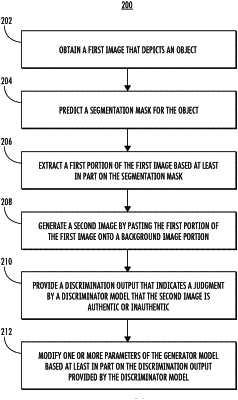| CPC G06N 3/084 (2013.01) [G06N 3/045 (2023.01); G06T 7/11 (2017.01); G06T 7/194 (2017.01); G06T 11/20 (2013.01); G06V 10/764 (2022.01); G06V 10/82 (2022.01); G06T 2207/20081 (2013.01); G06T 2207/20084 (2013.01); G06T 2210/12 (2013.01)] | 20 Claims |

|
1. A computing system, comprising:
one or more processors; and
one or more non-transitory computer-readable media that collectively store:
a generative adversarial network that comprises a generator model and a discriminator model; and
instructions that, when executed by the one or more processors, cause the computing system to perform operations to train the generative adversarial network for object segmentation, the operations comprising:
obtaining a first image that depicts an object, the first image comprising a plurality of pixels;
predicting, by the generator model, a segmentation mask for the object, wherein the segmentation mask identifies a subset of the plurality of pixels that correspond to the object;
extracting a first portion of the first image based at least in part on the segmentation mask, wherein the first portion comprises the subset of the plurality of pixels;
generating a second image by pasting the first portion of the first image onto a background image portion;
providing, by the discriminator model, a discrimination output that indicates a judgment by the discriminator model that the second image is authentic or inauthentic; and
modifying one or more parameters of the generator model based at least in part on the discrimination output provided by the discriminator model.
|